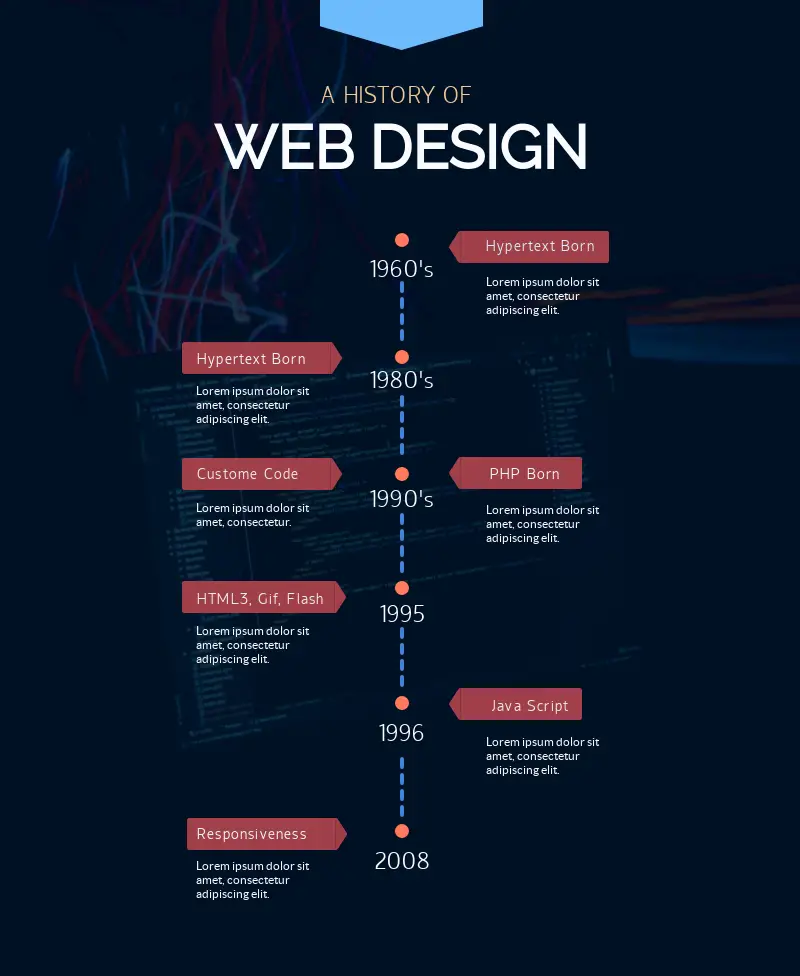Visual Studio and the Evolution of Web Design

Visual Studio is a powerful and versatile integrated development environment (IDE) that enables developers to build a wide range of applications, including web applications. Over the years, Visual Studio has played a significant role in the evolution of web design by providing developers with tools and features that have helped to shape the way websites are created and experienced.

In the early days of the web, websites were static and consisted primarily of text and images. As the web evolved, so too did the demand for more interactive and dynamic websites. This led to the development of new programming languages and frameworks, such as ASP.NET, which enabled developers to create more sophisticated web applications.

Visual Studio has been at the forefront of this evolution, providing developers with a powerful and easy-to-use platform for building web applications. With its built-in support for ASP.NET, Visual Studio makes it easy for developers to create web applications that are scalable, secure, and maintainable. Additionally, Visual Studio provides a range of tools and features that help developers to design and develop web applications quickly and efficiently.
One of the key benefits of using Visual Studio for web development is its support for drag-and-drop functionality. This makes it easy for developers to create web pages and applications by simply dragging and dropping elements onto the design surface. Visual Studio also provides a wide range of templates and components that can be used to jump-start the development process.
Another benefit of using Visual Studio for web development is its built-in support for debugging and testing. This makes it easy for developers to identify and fix errors in their code, as well as to test the functionality of their web applications. Visual Studio also provides a range of tools and features that help developers to optimize the performance of their web applications.
Overall, Visual Studio has played a significant role in the evolution of web design by providing developers with a powerful and easy-to-use platform for building web applications. With its built-in support for ASP.NET, drag-and-drop functionality, and debugging and testing tools, Visual Studio is an ideal choice for developers who are looking to create high-quality web applications quickly and efficiently.
Here are some additional details on how Visual Studio has contributed to the evolution of web design:
- Support for Responsive Web Design: Visual Studio includes a range of tools and features that help developers to create web applications that are responsive and can be accessed on a variety of devices, including desktop computers, laptops, tablets, and smartphones.
- Integration with Source Control Systems: Visual Studio provides seamless integration with popular source control systems, such as Git and Subversion. This makes it easy for developers to manage the code for their web applications and collaborate with other developers.
- Cloud Deployment: Visual Studio makes it easy for developers to deploy their web applications to the cloud. This can be done using a variety of cloud platforms, such as Microsoft Azure, Amazon Web Services, and Google Cloud Platform.
- Cross-Platform Development: Visual Studio supports the development of web applications that can be deployed on a variety of platforms, including Windows, macOS, and Linux. This makes it easy for developers to create web applications that can be used by a wide range of users.# Visual Studio and the Evolution of Web Design
Executive Summary:
Visual Studio is a powerful integrated development environment (IDE) that has revolutionized the way web designers and developers create and maintain websites. With its comprehensive set of features and tools, Visual Studio enables users to streamline their workflow, enhance productivity, and craft sophisticated web applications. This article explores the profound impact of Visual Studio on the evolution of web design, highlighting its key contributions to the industry.
Introduction:
The rapid evolution of web design has been driven by numerous factors, including the introduction of advanced software tools and technologies. Among these, Visual Studio stands out as a pivotal platform that has transformed the way websites are conceptualized, developed, and deployed. This comprehensive IDE offers a wide range of capabilities that cater to the diverse needs of modern web designers and developers, allowing them to bring their creative visions to life with greater efficiency and precision.
1. Intuitive Interface & User-friendly Design:
Visual Studio’s user interface is meticulously crafted to provide an intuitive and seamless experience for users. Its clean and organized layout, coupled with a customizable workspace, enables developers to navigate through various features and tools effortlessly. The IDE’s intuitive design accelerates the learning curve for novice users, allowing them to quickly grasp the fundamentals and focus on productive web development.
– Customizable Workspace: Tailor the interface to suit individual preferences, including arranging toolbars, windows, and panels to optimize the workflow.
– Context-sensitive Help System: Access instant assistance and documentation relevant to the task at hand, reducing the need to consult external resources.
– IntelliSense Code Completion: Leverage intelligent code completion and error detection features to write code faster and minimize syntax errors.
– Syntax Highlighting and Code Formatting: Enhance code readability and maintain consistency throughout the project with automatic syntax highlighting and code formatting.
2. Comprehensive Web Development Tools:
Visual Studio’s extensive toolkit encompasses a vast array of features and tools specifically designed for web development. These tools empower designers and developers to create dynamic and engaging web applications with ease. From coding and debugging to testing and deployment, Visual Studio provides a comprehensive solution for the entire web development lifecycle.
– Integrated HTML, CSS, and JavaScript Editors: Seamlessly edit HTML, CSS, and JavaScript code within a single environment, facilitating rapid prototyping and agile development.
– Built-in Debuggers: Utilize powerful debuggers to identify and resolve errors in code, reducing development time and improving the overall quality of the web application.
– Cross-platform Compatibility: Develop web applications that seamlessly run on different platforms, including Windows, Mac, and Linux, ensuring wider accessibility.
– Extensive Library of Extensions: Access a vast repository of extensions and plugins that further enhance Visual Studio’s capabilities and cater to specialized development needs.
3. Collaboration and Version Control Integration:
Visual Studio fosters seamless collaboration among team members and facilitates efficient management of code changes through its integration with version control systems. This promotes transparency, accountability, and streamlined development processes, enabling teams to work together effectively on complex web projects.
– Git and Other Version Control Systems: Integrate with popular version control systems such as Git, enabling developers to track code changes, manage branches, and collaborate seamlessly.
– Real-time Collaboration Features: Collaborate in real-time with team members, allowing multiple users to simultaneously edit and review code, enhancing productivity and communication.
– Code Reviews and Pull Request Management: Facilitate code reviews and manage pull requests, enabling teams to provide feedback, discuss changes, and merge code efficiently.
– Conflict Resolution and Branch Management: Visual Studio’s conflict resolution tools and branch management capabilities streamline the merging of code changes and help teams resolve conflicts effectively.
4. Rapid Prototyping and Live Preview:
Visual Studio’s rapid prototyping capabilities and live preview features empower designers and developers to visualize their designs and experience the application’s functionality in real-time. This iterative approach accelerates the development process, enabling teams to quickly iterate on ideas, gather feedback, and refine the user experience.
– WYSIWYG Editor: Leverage a WYSIWYG (What You See Is What You Get) editor to create and modify web pages visually, simplifying the design process for non-technical users.
– Live Preview and Debugging: Preview design changes and test application functionality in real-time within the IDE, enabling developers to identify and resolve issues early in the development cycle.
– Cross-device Emulation: Emulate different devices and screen sizes to ensure that the web application renders correctly across various platforms and devices.
– Responsive Design Tools: Utilize responsive design tools to create websites that automatically adjust their layout and content based on the device’s screen size.
5. Performance Optimization and Troubleshooting:
Visual Studio provides a comprehensive set of tools and features to optimize the performance and troubleshoot issues in web applications. These tools help developers identify and resolve bottlenecks, improve application efficiency, and deliver a seamless user experience.
– Performance Profiling: Utilize profiling tools to analyze application performance, identify bottlenecks, and optimize code for improved efficiency.
– Memory Management and Leak Detection: Monitor memory usage and detect memory leaks, enabling developers to identify and resolve memory allocation issues.
– Exception Handling and Debugging: Handle exceptions gracefully and debug errors effectively with Visual Studio’s exception handling and debugging capabilities.
– Logging and Tracing: Implement logging and tracing mechanisms to track application behavior, identify potential issues, and facilitate troubleshooting.
Conclusion:
Visual Studio has revolutionized the landscape of web design, providing a comprehensive platform that caters to the diverse needs of web designers and developers. Its intuitive interface, comprehensive toolset, collaboration features, prototyping capabilities, and performance optimization tools have significantly transformed the way web applications are conceived, developed, and deployed. As Visual Studio continues to evolve, it remains an indispensable partner for those seeking to create innovative and engaging web experiences. Its continuous advancements have paved the way for a new era of web development, where creativity and technological innovation converge to shape the future of the internet.
Keyword Phrase Tags:
- Visual Studio Web Design
- Web Development Tools
- Collaboration and Version Control
- Rapid Prototyping and Live Preview
- Performance Optimization and Troubleshooting

Whoa! This is amazing! Visual Studio has come such a long way since I first started using it.
I can’t believe how much easier Visual Studio has made web design. It used to be such a pain!
I’m not a web designer, but even I can see how powerful Visual Studio is.
Visual Studio is great for prototyping new design ideas.
I’m not sure I understand all the technical details, but Visual Studio seems really user-friendly.
Visual Studio is the best web design software ever! It’s so easy to use, even a monkey could do it.
Oh my God! Visual Studio is so complicated! I can’t figure out how to do anything.
I’ve been using Visual Studio for years, and I still find new things to learn every day.
Visual Studio is a great tool, but it can be a bit overwhelming at first.
I’m not a web designer, but I’m sure Visual Studio is great.
Visual Studio is the best web design software on the market.